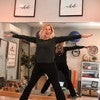Premium Continuing Education workshop
You can view a 2 minute preview. For details, scroll down below the video.
Description
Objectives: Students will be able...
• To find various ways of implementing a Pilates children’s program into a variety of settings
• To interpret different behavioral considerations for the child learner
• To interpret different cognitive considerations for the child learner
• To interpret different physiological considerations for the child learner
• To interpret different anatomical considerations for the child learner
• To design a lesson plan for a children’s Pilates class
• To design a warm-up for children’s Pilates class
• To recognize exercises that can be executed in a children’s Pilates class
• To implement the props into a children’s Pilates class
• To generate and implement activities into a children’s Pilates class
• To design a cool down for a children’s Pilates class
Materials Needed
Floor Space, Mats, Flip Chart Paper, Markers, Balloons, Music, Medium Size Balls, Physio Balls, Scooter, Rubber Ducky, Wall Space
About This Video
Continuing Education Credits
If you complete this workshop, you will earn:
3.0 credits from National Pilates Certification Program (NPCP)
The National Pilates Certification Program is accredited by the National Commission for Certifying Agencies (NCCA)
Workshops: Special Populations
Comments
What age groups are the best to start working with small children? I have a 3 yo granddaughter and would love to train her up in Pilates but right now not sure she mature enough to sit through a long class.. shes bouncy with high energy to say the least.
He also talks about how to keep their attention and how that differs with different age groups. I'm telling you this is a fantastic workshop (in my opinion). I learned tons of things that help me with any age student.
Update: The quiz is now working for this workshop. Thanks again for your patience.
You need to be a subscriber to post a comment.
Please Log In or Create an Account to start your free trial.




































